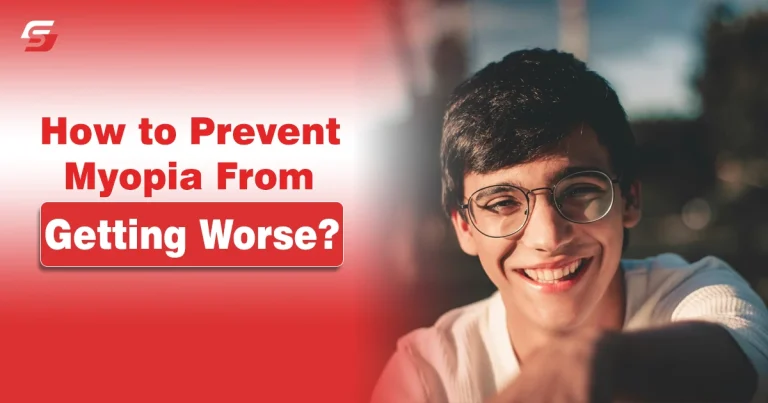When you think of the word epidemic, you probably think of contagious diseases, like measles and the flu—not nearsightedness. However, that’s exactly what’s happening: health experts now believe there’s an ongoing myopia epidemic.
The condition, which blurs the vision and makes it harder to clearly see things further away, is usually determined by genetics. Today, however, kids and young adults who spend a lot of time using digital devices are getting diagnosed with it. All that time spent looking at screens up close causes their still-developing eyes to elongate, causing nearsightedness. That led to a 2024 study from the British Journal of Ophthalmology concluding that cases of myopia across the globe will exceed 740 million by as early as 2050.
The important thing to remember about myopia is that it can worsen over time. Young adults and parents of kids – dealing with it need to be especially wary about high myopia, which increases the risk of vision loss. Fortunately, this is one condition that can easily be managed and even slowed down. Try these tips to get started!
Experts Tips for Preventing from Myopia
It should always be on your top list every time to follow the primary measures that are valuable in your overall visual health.

1. Prioritize Comprehensive Eye Exams
The eye exam is arguably the first and most important step you can take to keep myopia from getting worse. Think of it like a good deep cleaning for your teeth: unlike regular cleanings, it’s designed to slow the progression of oral health conditions like gum recession. In a similar vein, a comprehensive eye exam—not a basic one—goes beyond checking for 20/20 vision by looking at how myopia affects all parts of the eye.
Booking one with an optometrist or ophthalmologist will be crucial for helping you keep track of myopia as it progresses. A comprehensive exam will also give you more than a prescription for corrective eyewear like eyeglasses and contact lenses, as the eye care professionals that conduct it will also provide detailed and tailored advice on how to manage your particular case of myopia. They can even suggest further methods to control its progression!
For example, they may prescribe special atropine eye drops to use on top of wearing glasses or contacts—studies find that by dilating the pupils and stopping the eye’s focus mechanism, they can slow myopia by half compared to those who don’t use them.
2. Spend More Time Outdoors
Given how much excess screen time can speed up myopia progression, it’ll help to take more breaks and spend time outdoors. Aside from letting your eyes rest, doing so offers the additional benefit of sun exposure. The Vitamin D in sunlight is vital for spurring normal eye growth, especially in kids and young adults.
However, you’ll have to be cautious about just how much sun you’re getting. According to the International Myopia Institute, nearsightedness increases your risk of developing blindness-causing diseases like cataracts and myopic macular degeneration. Overexposure to the sun’s UV rays makes you more likely to develop these exact same conditions.
As such, it’s ideal to wear sunglasses that protect your eyes. Fortunately, you don’t need to wear them on top of your glasses: consider getting prescription sunglasses instead. The models available from Ray-Ban show that you can get prescription lenses on stylish frames like the Aviator and Wayfarer Classic for both form and function. Other pairs can accommodate even higher prescriptions ranging from -3.5 to +3.5, so your eyes can get the Vitamin D they need without absorbing dangerous amounts of UV rays.
3. Optimize your Device Use
Even though getting out of the house more often is one of the best ways to keep myopia from worsening, it’s also true that we need to use gadgets – not only for leisure, but for necessary tasks at work and in school. That said, excess screen time is often inevitable. In these cases, why not rework how you use devices, instead?
For example, many eye care professionals promote the 20-20-20 rule. Take a break from your screen every 20 minutes, then focus on an object 20 feet away for 20 seconds. Doing so can give the eye muscles a break so the eyeball doesn’t elongate further.
You’ll also want to match the brightness of your screen and environment, and keep your device at least an arm’s length away, so your eyes don’t strain just to see clearly.
You can even use an eye-friendly smartphone to ward off myopia progression! Take the eye health features in the Honor Magic 5 Pro from Geekzilla.tech. These include an eye comfort mode that warms the screen to prevent eye strain – and, more notably, an AI-powered Defocus Eye Protection tool specifically designed to tackle myopia.
Meanwhile, iPhones running on iOS 17 offer features like Time in Daylight and Screen Distance. These can tell you when it’s time to head outdoors for some sun or when your screen is too close to your face. That said, it’s worth checking if your phone has vision health-focused features that you can use to keep myopia from worsening.
4. Incorporate Myopia-Control Lenses
Myopia control lenses are particular glasses or contact lenses to slow down the progression of nearsightedness. Options like orthokeratology (Ortho-K) lenses reshape the cornea overnight and provides wearers to see clearly during the day without glasses while also reduces eye elongation.
Multifocal contact lenses and specially designed eyeglasses can also benefit by redistributing focus on the retina to minimize strain. Consult your optometrist to find out which option is best for your needs.
5. Maintain a Healthy Diet for Eye Health
A balanced diet rich in nutrients like Vitamin A, C, and E, as well as omega-3 fatty acids, can support overall eye health and reduce the risk of myopia complications. Some food routines to consume for developing a resistance in the body against myopia are necessary.
- Vitamin A, found in foods like carrots, sweet potatoes, and spinach, supports the retina and improves night vision.
- Vitamin C, abundant in citrus fruits and bell peppers – strengthens the blood vessels in the eyes and protects against cataracts.
- Omega-3 fatty acids, found in salmon, flaxseeds, and walnuts, reduce dry eye symptoms and support retinal function.
These nutrient rich foods in your daily meals, alongside other preventive measures like regular eye exams and reducing screen time, can expressively benefit your eyes and slow myopia progression.
Final Summary:
Undoubtedly, Myopia is a growing issue, but it’s manageable with the right habits and interventions. These nutrient rich foods in your daily meals, alongside other preventive measures like regular eye exams and reducing screen time, can expressively benefit your eyes and slow myopia progression.
All you need to do is to protect your myopia through the preventive measures. These measures along with your eyes will also protect the other parts of your body.






